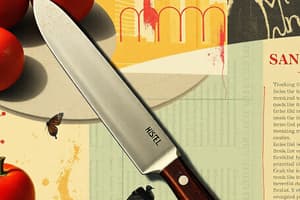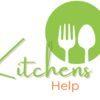Podcast
Questions and Answers
Soaking a knife in a sink with other tools and equipment can potentially lead to contamination of the knife.
Soaking a knife in a sink with other tools and equipment can potentially lead to contamination of the knife.
True (A)
It is completely safe to leave a knife soaking in soapy water for an extended period without monitoring.
It is completely safe to leave a knife soaking in soapy water for an extended period without monitoring.
False (B)
Using soap to soak a knife is an effective cleaning method for eliminating bacteria.
Using soap to soak a knife is an effective cleaning method for eliminating bacteria.
True (A)
Soaking knives in separate containers instead of a shared sink can minimize safety risks.
Soaking knives in separate containers instead of a shared sink can minimize safety risks.
Soaking knives in water with soap does not require any additional cleaning methods afterward.
Soaking knives in water with soap does not require any additional cleaning methods afterward.
Food should be cooked at temperatures above $145°F$ to ensure harmful bacteria are killed.
Food should be cooked at temperatures above $145°F$ to ensure harmful bacteria are killed.
Perishable foods should be refrigerated at temperatures below $40°F$ to maintain safety.
Perishable foods should be refrigerated at temperatures below $40°F$ to maintain safety.
It is acceptable to leave cooked food at room temperature for up to $6$ hours before refrigerating.
It is acceptable to leave cooked food at room temperature for up to $6$ hours before refrigerating.
Sanitizing utensils ensures that they are safe to use without any further cleaning required.
Sanitizing utensils ensures that they are safe to use without any further cleaning required.
Wearing a clean apron is a personal hygiene measure while preparing food.
Wearing a clean apron is a personal hygiene measure while preparing food.
Using a single cutting board for both raw meat and vegetables is acceptable as long as it is cleaned afterwards.
Using a single cutting board for both raw meat and vegetables is acceptable as long as it is cleaned afterwards.
All food items containing allergens must be clearly labeled to ensure safety.
All food items containing allergens must be clearly labeled to ensure safety.
Food waste should be disposed of in any manner as long as it's out of sight.
Food waste should be disposed of in any manner as long as it's out of sight.
Long hair should be let loose while cooking to avoid discomfort.
Long hair should be let loose while cooking to avoid discomfort.
Fruits and vegetables can be left out at room temperature indefinitely without risking spoilage.
Fruits and vegetables can be left out at room temperature indefinitely without risking spoilage.
Flashcards
Knife Soaking Risk
Knife Soaking Risk
Contamination from bacteria when knives are mixed with other tools in a sink.
Soap's Cleaning Power
Soap's Cleaning Power
Soap helps remove bacteria, ensuring a clean cooking environment.
Safe Soaking
Safe Soaking
Soak knives in separate containers to avoid cross-contamination.
Soaking Vigilance
Soaking Vigilance
Signup and view all the flashcards
Clean Hands
Clean Hands
Signup and view all the flashcards
Food Separation
Food Separation
Signup and view all the flashcards
Cooking Temperatures
Cooking Temperatures
Signup and view all the flashcards
Safe Chilling
Safe Chilling
Signup and view all the flashcards
Hygiene Practices
Hygiene Practices
Signup and view all the flashcards
Safe Thawing
Safe Thawing
Signup and view all the flashcards
Leftover Storage
Leftover Storage
Signup and view all the flashcards
Airtight Storage
Airtight Storage
Signup and view all the flashcards
Allergen Awareness
Allergen Awareness
Signup and view all the flashcards
Waste Disposal
Waste Disposal
Signup and view all the flashcards
Outbreak Response
Outbreak Response
Signup and view all the flashcards
Study Notes
Knife Soaking and Contamination Risks
- Soaking a knife in a sink with other tools can lead to contamination due to cross-contact with bacteria from various surfaces.
- Leaving a knife soaking in soapy water unattended is not advisable, as it may pose a risk of contamination.
Cleaning Effectiveness
- Soaking a knife in soap and water is a useful method for removing bacteria and ensuring cleanliness.
- Using soap is an effective method that helps in eliminating germs during the cleaning process.
Best Practices for Soaking Knives
- To enhance safety, knives should be soaked in separate containers, which reduces the risk of contamination from other utensils present in a shared sink.
- Removal of a knife from soapy water does not substitute the need for subsequent thorough cleaning practices.
Safety Recommendations
- Regular monitoring of knives soaked in water is essential to prevent any potential health risks.
- Implementing good practices for handling and cleaning kitchen tools can greatly minimize the likelihood of cross-contamination.
Importance of Food Safety
- Preventing foodborne illnesses is essential for public health and safety.
- Food quality and taste significantly rely on proper safety measures during preparation and storage.
- Maintaining customer trust is crucial for business success and reputation.
Key Principles of Food Safety
- Cleanliness:
- Thorough handwashing with soap and water is vital before food handling.
- Regular cleaning of surfaces, utensils, and equipment minimizes contamination risks.
- Separation:
- Keeping raw and cooked foods apart is necessary to prevent cross-contamination.
- Utilizing different cutting boards for meats and vegetables reduces the risk of bacteria transfer.
- Cooking:
- Cooking foods to appropriate temperatures is essential for killing harmful bacteria.
- A food thermometer ensures that meat and poultry reach safe internal temperatures.
- Chilling:
- Perishable items should be refrigerated at temperatures below 40°F (4°C) to inhibit bacterial growth.
- Food should not remain at room temperature for more than 2 hours to minimize spoilage and contamination.
Personal Hygiene
- Wearing clean clothing and an apron is required to maintain hygiene standards.
- Long hair should be tied back to prevent it from contaminating food.
- Cooking while ill, especially with gastrointestinal symptoms, poses a health risk and should be avoided.
Safe Food Handling Practices
- Regularly check expiration dates to ensure food safety and quality.
- Thawing frozen food must be done in the refrigerator, not at room temperature, to prevent bacterial growth.
- Sanitized utensils and equipment are critical in maintaining a hygienic cooking environment.
Storage Safety
- Leftovers should be refrigerated within 2 hours to keep them safe for consumption later.
- Using airtight containers helps prevent contamination and maintains food freshness.
- Proper labeling and dating of food items assist in tracking freshness and reducing waste.
Food Allergies
- Awareness of common allergens such as nuts, dairy, and gluten is essential in food preparation.
- Clearly labeling food items containing allergens informs consumers and prevents adverse reactions.
Waste Management
- Proper disposal of food waste is necessary to avoid attracting pests and maintaining a clean environment.
- Follow local regulations for food waste disposal to ensure compliance and community health.
Emergency Measures
- Understanding how to respond to foodborne illness outbreaks is crucial for protecting public health.
- Keeping emergency contact numbers for local health departments readily available can expedite responses to health crises.
Studying That Suits You
Use AI to generate personalized quizzes and flashcards to suit your learning preferences.





